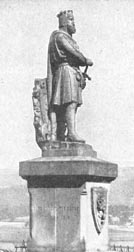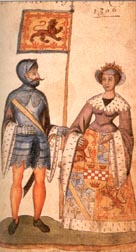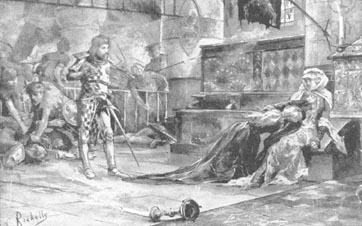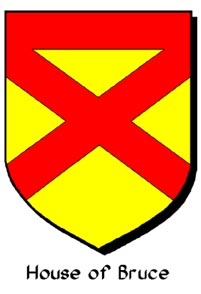 |
left: Statue of King Robert the Bruce at
Stirling.
right: Robert the Bruce and his first wife Isabel of Mar |
 |
 |
left: Statue of King Robert the Bruce at
Stirling.
right: Robert the Bruce and his first wife Isabel of Mar |
 |
The following is quoted from:
Norman F. Cantor (ed.) The Encyclopędia of
the Middle Ages, New York, 1999 pages 362 – 363:
“Robert I (1274 – 1329) the Bruce holds an honored place in Scottish history as the king (1306 – 1329) who resisted the English and freed Scotland from their rule. He hailed from the Bruce family, one of several who vied for the Scottish throne in the 1200s. His grandfather, also named Robert the Bruce, had been an unsuccessful claimant to the Scottish throne in 1290. Robert I Bruce became earl of Carrick in 1292 at the age of 18, later becoming lord of Annandale and of the Bruce territories in England when his father died in 1304.
“In 1296, Robert pledged his loyalty to King Edward I of England, but the following year he joined the struggle for national independence. He fought at his father’s side when the latter tried to depose the Scottish king, John Baliol. Baliol’s fall opened the way for fierce political infighting. In 1306, Robert quarreled with and eventually murdered the Scottish patriot John Comyn, lord of Badenoch, in their struggle for leadership. Robert claimed the throne and traveled to Scone where he was crowned king on March 27, 1306, in open defiance of King Edward.
“A few months later the English defeated
Robert’s forces at Methven. Robert fled to the west, taking refuge on the
island of Rathlin off the coast of Ireland. Edward then confiscated Bruce
property, punished Robert’s followers, and executed his three brothers.
A legend has Robert learning courage and perseverance from a determined
spider he watched during his exile.
 |
After the battle near Methven, in Perthshire, in the early days of Bruce's struggles against England, many Scottish nobles were executed. Bruce's wife and daughter Marjory were seized in the sanctuary of St. Duthac at Tain, and were held prisoners in England for eight years, while the knights who were in attendance upon them were put to death. |
“Robert returned to Scotland in 1307 and won a victory at Loudon Hill. Edward I launched a campaign against the Scottish rebels, but he died on his way north. He was succeeded by his son, Edward II, who was unable to continue his father’s campaign. Robert launched his own campaign to regain control of Scotland, beginning in the north and advancing south, seizing one region after another and recapturing lands and castles from the English. In 1313, he captured Perth; a year later at Bannockhurn, he inflicted a crushing defeat on a large English force under the command of Edward II. As the war continued, the Scots recaptured Berwick in 1318. When the English refused to make peace or acknowledge Robert as king of Scotland, Robert raided northern England as well.
“In 1327, yet another English king, Edward III, tried to crush the Scottish rebellion. When he failed, the English crown finally agreed to the Treaty of Northampton (1328) that recognized the independence of Scotland and Robert’s right to the throne. The treaty also provided for the marriage of Robert’s son David to King Edward’s sister. Robert spent the brief remaining years of his life in his castle in Cardross, where he died in 1329.
“Robert solidified Scotland’s status as an independent kingdom by securing an orderly succession for his son, who became King David II.”
Click to return to the Scotland
Page
 The
ancestors of Robert the Bruce, King of Scotland seem very certain back
to his great grandparents Robert Bruce and Isobella le Scot, a daughter
of David, Earl of Huntingdon who was in turn a grandson of David the Saint
of Scotland, King of Scotland from 1124 to 1153. Isobella le Scot was also
a niece of Malcolm (IV) the Maiden, King of Scotland from 1153 to 1165
and his brother William (I) the Lion, King of Scotland from 1165 to 1214.
Please click HERE
for this ancestry that leads back to the ancient Kings of Scotland.
The
ancestors of Robert the Bruce, King of Scotland seem very certain back
to his great grandparents Robert Bruce and Isobella le Scot, a daughter
of David, Earl of Huntingdon who was in turn a grandson of David the Saint
of Scotland, King of Scotland from 1124 to 1153. Isobella le Scot was also
a niece of Malcolm (IV) the Maiden, King of Scotland from 1153 to 1165
and his brother William (I) the Lion, King of Scotland from 1165 to 1214.
Please click HERE
for this ancestry that leads back to the ancient Kings of Scotland.
The ancestors of Robert Bruce, great grandfather of Robert the Bruce, King of Scotland have been more difficult to trace. The family name is spelt in different sources as le Bruce, de Bruce, Brus, Bruis, Brix, Brusse and even Broase. Here, we will attempt to simplify the situation by using of "Bruce."
Here is the best line of descent that we have been able to come up with. Please send corrections and suggestions to Robert Sewell.
Generation One
Robert de Bruce I
Died about 1094.
Robert was a Norman knight from Bruis,
a castle near Cherbourg, France. He came to England with William I the
Conqueror and was rewarded by the gift of many manors, chiefly in Yorkshire,
of which Skelton was the principal. He married Agnes, daughter of Walderne,
Earl of St. Clair and had a son:
William de Bruce
died between 1199 and 1215.
William was the youngest son.
Sir William Bruce (died between 1199 and 1215) had a
son:
Sources of Information
The material presented above has been drawn from numerous sources:
Thanks to Carol Davis for sharing
the following account from Funk & Wagnalls New Encyclopedia
that shows the Bruce Family as descendants of a Companion
of William the Conqueror in 1066:
"BRUCE, family in Scottish history, originally named de Bruce, descended from Robert de Bruce I (d. about 1094). De Bruce was a Norman knight from Bruis, a castle near Cherbourg, France, who in 1066 went to England with William the Conqueror, later William I, King of England.
"Robert de Bruce II (d. 1141), son of Robert de Bruce I, was a companion in arms of Prince David of Scotland, afterward David I, from whom he received a grant of the lordship of Annandale (now the county of Dumfries).The English estates of Robert de Bruce II were inherited by his eldest son, whose male line terminated in Peter Bruce (d. 1271), Constable of Scarborough.
"Annandale passed to the second son, Robert de Bruce III (d. 1189?), who is considered the founder of the Scottish branch of the family. He had two sons: Robert de Bruce IV (d. 1191?), who in 1183 married a daughter of William the Lion, King of Scotland; and William de Bruce (fl. 1191) whose son Robert de Bruce V (d. 1245) married a niece of William the Lion, thus laying the foundation for the claim of the House of Bruce to the Scottish throne.
"The son of Robert de Bruce V, Robert de Bruce VI (1210-1295), called the Competitor, vied unsuccessfully for the Scottish throne with John de Baliol. The son of Robert de Bruce VI, Robert de Bruce VII, Earl of Carrick (1253-1304), paid homage to Edward I, King of England.
"In 1306 the son of Robert de Bruce VII, Robert de Bruce VIII, usually known as Robert Bruce, became king of Scotland as Robert I. The Scottish throne passed to his son, David Bruce, known as David II, King of Scotland; he died without an heir. David's nephew, also the grandson of King Robert I, ascended to the Scottish throne as Robert II (q.v.) and founded the Stuart house of kings of England and Scotland."
"BRUCE FAMILY. Scottish Family also spelt Bruis, Brix, or Broase.
"The family is descended from Robert de Bruce (d. 1094?), a Norman knight who came to England with William I the Conqueror and who was awarded by the gift of many manors, chiefly in Yorkshire, of which Skelton was the principal. His son, the second Robert de Bruce (1078?–1141), received from Scotland’s King David I, his comrade at the English court of Henry I, a grant of the lordship of Annandale, in Scotland. The second Robert later grew estranged from David and renounced his Scottish fief of Annandale, which, however, was restored to his son, the third Robert (fl. 1138–89?).
"The family’s royal connections began when the fourth Robert (d. before 1191) married Isabel, who was the natural daughter of William I the Lion, king of Scotland. Their son, the fifth Robert (d. 1245), married Isabel, second daughter of David, Earl of Huntingdon, and niece of William I.
"The sixth Robert (1210–95), son of the fifth, was one of the 13 claimants to the Scottish throne in 1291. When the English king Edward I decided in favour of John de Balliol, Robert de Bruce resigned Annandale to his son, the seventh Robert (1253–1304), who was already (by marriage) Earl of Carrick. The eighth Robert de Bruce (1274–1329) revived his grandfather’s claim to the throne and became King Robert I of Scotland in 1306. Robert I established Scottish independence from England and is revered as one of Scotland’s great national heroes. His brother Edward (d. 1318) was killed while fighting to make himself effective king of Ireland.
"The direct line of the Bruces ended in 1371 with the death of King Robert’s son, David II (1324–71). The crown of Scotland then passed to a grandson of Robert I (through the female line)—namely, Robert Stewart, who, as Robert II, was the first of the Scottish royal house of Stewart (later, Stuart) and ancestor of the English house of Stuart."
Items at some internet "chat rooms"
and genealogy sites suggest an earlier Scottish connection by claiming
that a great grandfather of Robert de Bruce I (d. ca. 1094) was a Danish
or Norwegian Earl of Caithness & Sunderland named "Brusse", but the
sources (when given) for these suggestions were convoluted and confused
at best. Regardless, it appears that the House of Bruce is not an
ancient Celtic or Scottish family.
|
the Dictionary of National Biography, Leslie Stephen, editor, 1886, Vol VII, pages 114 to 117: |
BRUCE, ROBERT DE I (d. 1094?), was an ancestor
of the King of Scotland who made the name of Bruce famous. Earlier
genealogy tracing to a follower of Rollo
cannot be accepted. His son:
|
BRUCE, ROBERT DE II (1078 – 1141) was a son of
Robert I, and a companion of David I of Scotland at the court of Henry
I. He received from David I a grant of Annandale by a charter circa 1124.
M. Agnes, dau. of Fulk Pagnal of Carlton. Sons:
|
| BRUCE, ROBERT DE III (fl. 1138 – 1189?)
Held Annandale and was founder of the Scottish branch. Sons:
|
BRUCE, WILLIAM DE (d. 1215) who was the only exception
to the line of Roberts. William held Annandale along with the English manors
of Hert and Haltwhistle until his death in 1245. His son:
|
BRUCE, ROBERT V (d. 1245) Son of William de Bruce.
M. Isabel, 2nd dau of David Earl of Huntingdon, younger brother of William
the Lion and thus founded the claim of his descendants to the crown. His
son:
|
BRUCE, ROBERT VI (1210 – 1295) "the Competitor
" M. Isabel, dau. of Gilbert de Clare. His son:
|
BRUCE, ROBERT VII M. Marjory, Countess of Carrick
His son:
|
| BRUCE, ROBERT VIII (July 11, 1274 – 1329) King
of Scotland.
and use your browser's back button to return to this page. |
| An interesting account showing a Scandinavian ancestry for the Bruce Family is found in Florence Van Rensselaer, The Livingston Family in America and Its Scottish Origins, New York, 1949, pages 30 and 31: |
|
The first Bruce to go to Normandy, had left Orkney, where his forbears had been earls, or jarls, since the fifth generation from their earliest known ancestor Sveide, of Upland, a Viking, circa 760, who ruled until he died, and thereafter his descendants for three generations lived in Denmark and Norway, one Sigurd, becoming the first Earl of Orkney. For six more generations, these hardy men fought by land and sea, when another Sigurd, the seventh Earl, married for his second wife Olith or Thora, daughter of Malcolm II, king of Scotland, and his grandson married as his second wife, Felicia, daughter of Robert Duke of Normandy, her brother being William the Conqueror. Their second son was named Brusi, or Robert de Brusee who first went to Norway, but before long attached himself to the service of his maternal grandfather, and settled in Normandy, where he became eminent and powerful in that Court; being Councillor to Robert I, Duke of Normandy, the grandfather referred to, built the Castle of “la Brusee or Bruis”, now Brix, which became “the Crade of the royal house of Scotland,” and married Emma, daughter of Alain, Earl of Brittany. Again after six generations the three last having been barons of Annandale, and all but two named Robert, came, |
| Robert de Brusee (Brus or Bruce) who was the fourth baron of Annandale, and died 1245, married lsabel de Huntingdon, daughter of David, Earl of Huntingdon, who was a son of Prince Henry of Scotland, and grandson of David I, King of Scots. The Earl of Huntingdon was brother to Malcolm IV, King of Scots, and of William the Lion, also King of Scots. He died in 1242. Thus the legitimate royal blood of Scotland was introduced into the Bruce family, which gave the descendants of this Robert Bruce their claim to the throne, where they later reigned. |
| Robert Bruce, Lord of Annandale 1245, and in 1252
he had his mother’s one-third share of the earldom of Huntingdon. His first
wife whom he married in 1240 was Isabel de Clare . . .
and use your browser's back button to return to this page. |
| Miss Van Rensselaer continues this genealogy a few pages on; the following is from Florence Van Rensselaer, The Livingston Family in America and Its Scottish Origins, New York, 1949, pages 55 to 58: |
|
|
| Sveide of Upland, a Viking 760-800. |
| Halfden, the Aged, ruler of Upland in 800, murdered by Gudrod, King of Scandia. |
| Ivar . . . a jarl or earl of Upland in 830, from whom came the early Kings of Sweden and of Denmark. |
| Euslin, named Glumra of Vors, fled into Norway to escape Danish tyranny. He married secondly Ascrida, daughter of Rognvald, son of Olaf an independent king of Norway. |
| Rognvald, Earl of Norther Mere and Raumsdale in 885, later Earl of South Mere married secondly Groa, daughter of Wrymund, King of Trondherm. When his son Ivar, fighting under King Harald was killed in Scotland, the King gave Earl Rognvald the Orkneys and Shetland. He died in 890. |
| Elnar Torf Elnar, fourth Earl of Orkney. The name
of his wife, and the date of his death are unknown.
Click HERE for details and use your browser's back button to return to this page. |
| Thorfinn Hausklifr, fifth Earl of Orkney, and in Earl of Shetland, married Grelad or Grelota, daughter of Dungad, jarl or earl of Cathanes. |
| Hlodver, or Lodver, sixth Earl of Orkney, died circa 980, and was buried at Hofu in Cathanes; married Audna, daughter of Kiarval, King of Ireland, King of Dublin 872 – 887. |
| Sigurd, seventh Earl of Orkney, who about 995
embraced Christianity; married secondly Olith, Alice or Thora, daughter
of Malcolm II King of Scotland. He was converted from paganism by King
Olaf Tryggvison of Norway who came on an expedition to Orkney and baptized
all the people of the Orkneys. He fought in several wars, and went in 1014
to Ireland where he was killed in the great combat at Clontarf 23 April
1014.
is not a genealogy but just a list of the ancient Earls of Orkney? Please send information to Robert Sewell. |
| Brusi, Earl of Orkney, and Earl of Cathanes and Sutherland. He died in 1031; married Ostrida, daughter of Regenwald Wolfson, Earl of Gothland. Earl Brusi held two-thirds of Orkney, by the support of King Olaf, of which he lost one half in 1030. He was converted to Christianity in the eleventh century. |
| Rognvald, Governor of the Castle of Oldegorburg in Russia, died post 1046; married second Feicia, daughter of Robert, Duke of Normandy. Early in life he was held in hostage at the court of King Olaf the Holy, of Norway. He took possession of Orkney and proclaimed himself ruler of all of his uncle’s dominion in Cathanes and Hebrides, and lived for a time on the Island of Papa Stronsay, later he was killed by Thorkell Fostri a follower of his uncle Thorfinn. |
| Brusi, or Robert de Brusee, who built the castle of La Brusee or Bruis, now Brix in Normandy, married Emma, daughter of Alain, Earl of Brittainy. |
| Sir Robert de Brusse, followed the standard of
William, Duke of Normandy into England in 1066, married Agnes, daughter
of Walderne, Earl of St. Clair. He was a man of distinguished character
and stood high in the favor of the Conqueror. He possessed many manors
in the several ridings of Yorkshire and died about 1094.
Sir Robert de Brusse is shown in Funk & Wagnalls New Encyclopedia and Encyclopędia Britannica 2009 where the next in line is shown as Sir Robert de Brusse (b. ca. 1078) and Sir Adelme de Brusse is not mentioned. |
| Sir Adelme or Adam de Brusee, came to England
in 1050 in attendance upon Emma of Normandy, married Emma de Ramsay, daughter
of Sir William de Ramsay. Emma de Normandy was a daughter of Richard I
of Normandy by his wife Gonnor, and became the Queen of Ethelred. King
of England. He joined the army of William the Conqueror, and received the
barony of Skelton and the lordship of Cleveland.
|
| Sir Robert de Brusee, born circa 1078, was the
head of the barony of Bruce, and died in 1141, married Agnes de Paganell
and became the first baron of Skelton and Annandale. He gave the church
of Middleburgh and some lands to the monks of Whitby to establish a cell
of the Abbey of Guisburn in Cleveland. In the Battle of the Standard on
August 22, 1138 he was in command of a large part of the army of the English
king. He was buried in Guisburn Priory.
Sir Robert de Brusse is shown in the Dictionary of National Biography,
Leslie Stephen, ed., 1886, Vol. VII, pg. 114
|
| Sir Robert de Brus, second baron of Annandale, adhered to the cause of King David. He married secondly Euphemia. — He also had lands in England, the lordship of Hart, in the bishopric of Durham, and through his first wife Judith, daughter of Sir William de Lancaster, Lord of Kendall, he succeeded to the possession of the Lordship of Kendall; his youngest son was: |
| Sir William de Brus, third baron of Annandale, he also held the English manors of Helt and Haltwhistle, the name of his wife is not on record. He died between 1199 and 1215; some authorities give the tenth year of the reign of King Richard I, while others the sixteenth year of the reign of King John I. |
| Sir Robert de Brus, fourth baron of Annandale,
died in 1245, and was buried in the Abbey of Sabre, near Stilton; married
Isabel
de Huntingdon, daughter of David, Earl of Huntingdon, son of Prince
Henry of Scotland and grandson of David I, King of Scots, thus bringing
the legitimate royal blood of Scotland into the Bruce family. By this royal
match the Lords of Annandale attained to high rank among the most powerful
and wealthy noble families of Scotland and England.
Miss Van Rensselaer indicates that the marriage of Sir Robert de Brus
to Iasbel de Huntingdon is responsible for
|
| Sir Robert Bruce, “The Competitor”, Lord of Annandale,
died on Good Friday in 1295; married first 1240 Isabel de Clare . . .
and use your browser's back button to return to this page. |
Click to return to the Scotland Page
Click to return to the top of this page.
Please visit the Sewell Genealogy Site Map for other pages.
|
|
 |